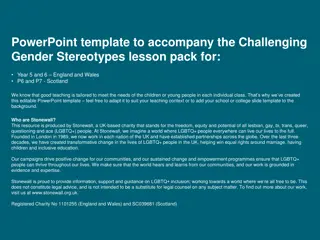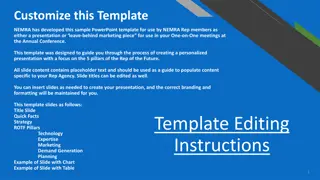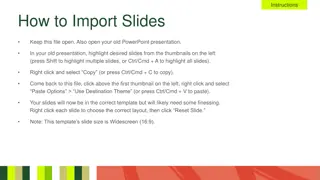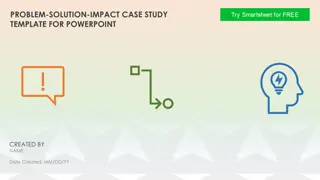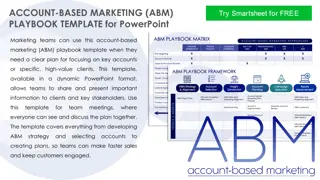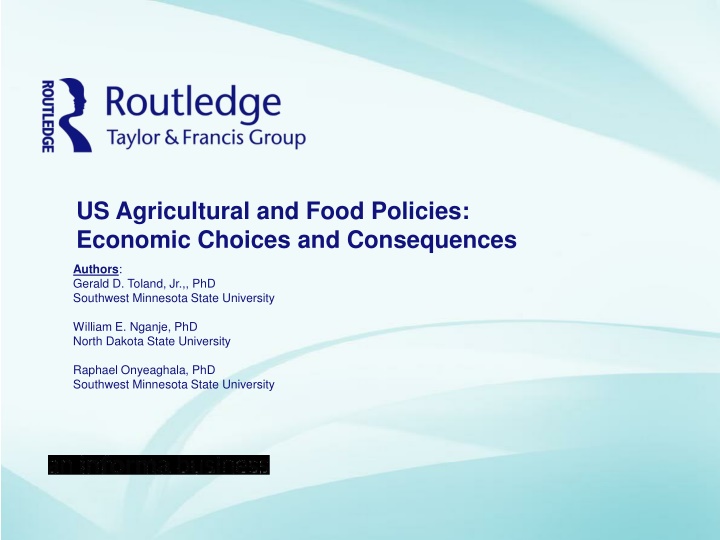
US Agricultural and Food Policies
Delve into the complexities of US Agricultural and Food Policies with this insightful book authored by experts in the field. Learn about the economic choices made, their consequences, and the challenges faced in policy analysis. Explore the dynamic nature of the agricultural and food system and its impact on society, markets, technologies, and global economics.
Download Presentation

Please find below an Image/Link to download the presentation.
The content on the website is provided AS IS for your information and personal use only. It may not be sold, licensed, or shared on other websites without obtaining consent from the author. If you encounter any issues during the download, it is possible that the publisher has removed the file from their server.
You are allowed to download the files provided on this website for personal or commercial use, subject to the condition that they are used lawfully. All files are the property of their respective owners.
The content on the website is provided AS IS for your information and personal use only. It may not be sold, licensed, or shared on other websites without obtaining consent from the author.
E N D
Presentation Transcript
US Agricultural and Food Policies: Economic Choices and Consequences Authors: Gerald D. Toland, Jr.,, PhD Southwest Minnesota State University William E. Nganje, PhD North Dakota State University Raphael Onyeaghala, PhD Southwest Minnesota State University
US Agricultural and Food Policies: Economic Choices and Consequences Chapter 1 - An Introduction to Policy Analysis Chapter One s Objectives: Introduce Agricultural and Food Policy as a field of study A productive area of research; a topic for lively discussion and debate Diverse and dynamic nature of the US agricultural and food system Encourage progressive learning Begin with a basic knowledge of policy Advance to higher learning skills: Critical Thinking Scenario and Case Study Analysis Problem solving This Course: Use it to become better informed citizens and policy analysts 2
US Agricultural and Food Policies: Economic Choices and Consequences Chapter 1 - An Introduction to Policy Analysis Why Study Agricultural and Food Policy? Our food and agricultural system supplies society with a necessity of life Agri-food markets uniquely influenced by a combination of powerful forces volatile prices perishable products societal safety concerns uncontrollable natural production conditions Private sector markets interact with government programs and regulations Successful policy design requires sophisticated analysis Technologies, Consumer Attitudes, Global Economics - continually changing Policies must evolve with the conditions, to be meaningful and effective 3
US Agricultural and Food Policies: Economic Choices and Consequences Chapter 1 - An Introduction to Policy Analysis The Value and Challenges of Policy Analysis Is Policy Analysis a valuable activity? If done correctly, yes. Ag & Food Policies allocate large volumes of scarce resources The 2014 Farm Bill accounts for over $90 Billion annually in federal spending Policy mistakes are very expensive Smarter policy designs can prevent waste, & direct resources to higher-value uses Policy Analysis and Design Difficulties and Challenges In theory, an efficient Pareto Better policy improves economic welfare for targeted groups while not reducing the welfare of other interests. Most policies do not meet the Pareto Better efficiency standard New policies often cause some to be better-off while making others worse-off Even if winners can compensate losers , we have no science-based criteria to determine if the policy change is equitable and desirable. 4
US Agricultural and Food Policies: Economic Choices and Consequences Chapter 1 - An Introduction to Policy Analysis Tools for Policy Analysis and Evaluation A Primary Method for Investigating Ag & Food Policies is: Applied Research and Problem Solving In Applied Research and Problem Solving Situations, there are two complementary means of study: Science-based methods of positive economics (research and analysis) The evaluative approach of normative economics to judge policy options and make recommendations (design and recommend) Policy Analysis requires that we utilize the methods of both positive and normative economics to explore options & make choices. 5
US Agricultural and Food Policies: Economic Choices and Consequences Chapter 1 - An Introduction to Policy Analysis Tools for Policy Analysis and Evaluation (Continued) When we employ positive economics: We scrutinize methods for scientific validity, reliability, and consistency. Goal: Achieve accurate and objective observations of correlation and causation. When we employ normative economics: We evaluate the goodness of a policy based on criteria such as fairness, equality, and transparency. Goal: Design, recommend and implement better policies. After we systematically review policy options, we recommend a particular policy decision based on its instrumental value as a relevant, usable, accessible and action-oriented choice. 6
US Agricultural and Food Policies: Economic Choices and Consequences Chapter 1 - An Introduction to Policy Analysis Direct Payment Program (DPP): A Case Study 2014 Farm Bill discontinued the DPP farm subsidy program. DPP had been a steady revenue source for participating US crop producers during 1996 - 2013. When we establish or eliminate a policy or program, we can gain insights into the policy change by examining the event using the tools of positive and normative economics. Within a case study, we use positive economics to: Identify of objective facts; e.g. predict $ savings from DPP s demise Make unbiased predictions of policy impacts; e.g. $ deficit reduction Generate forecasts using modern and valid modeling techniques Inform policy-makers about the range of possible outcomes associated with alternative policy choices 7
US Agricultural and Food Policies: Economic Choices and Consequences Chapter 1 - An Introduction to Policy Analysis Direct Payment Program (DPP): A Case Study (Continued) Within the DPP case study, we use normative economics to: Explore the value judgment that Congress should eliminate the DPP Public perception: DPP wasted taxpayer $ on a program that farmers did not need. DPP s removal allows funds to be redirected to more productive uses. Use normative concepts to review why Congress established the DPP in 1996: 1996 Farm Bill: Recommend that supply-and-demand should guide resource allocation in agriculture. The goal was to phase-out farm subsidies. The 1996 market-driven policy exposed farm operators to increased price and income volatility. Congress established DPP as a temporary policy to foster farm financial stability while moving agriculture towards a private market incentive system. 8
US Agricultural and Food Policies: Economic Choices and Consequences Chapter 1 - An Introduction to Policy Analysis A Systematic Method for Applied Policy Research Careful analysis of observed phenomena helps us discover correlations and cause-and-effect relationships. We summarize a systematic approach in the following six steps: Identify a clear purpose for the policy analysis. Use methods of both positive and normative economics. Organize preliminary information e.g., perform a literature search; assemble secondary data; engage focus groups; conduct informal & formal interviews. Use appropriate theoretical frameworks or models to identify policy options and formulate testable hypotheses. Engage in scientific data collection and data analysis techniques. Test hypotheses and evaluate the predicted impacts of alternative policies. Interpret results, reach conclusions, and make recommendations about alternative policies and their consequences. 9
US Agricultural and Food Policies: Economic Choices and Consequences Chapter 1 - An Introduction to Policy Analysis Connecting Policy-Analysis to Policy-Making We employ the six-step policy analysis approach (see previous slide) to carefully assess the outcomes of new policy options. Policymakers who need reliable information to make decisions utilize the results of the systematic six-step approach to: Identify a policy option as a definite action, Access the means for implementing it, and Accurately predict the end-results of making that decision. Careful planning, clear communication and productive research results are key elements when translating the results of policy analysis into usable knowledge for policy-making. 10
US Agricultural and Food Policies: Economic Choices and Consequences Chapter 1 - An Introduction to Policy Analysis Influential US Ag & Food Policies in the 21st Century: The 2010-2011 FSMA, the 2014 Farm Bill, and the 2015 Trade Act Important opportunities to engage in policy analysis are associated with three recent large-scale US legislative initiatives: The FDA Food Safety Modernization Act (FSMA). The US Congress approved the FSMA in December 2010. President Obama signed it into law on January 4, 2011. The Agricultural Act of 2014 (i.e., the 2014 Farm Bill). President Obama signed the 2014 Farm Bill into law on February 7, 2014. The 2015 Trade Act (H.R.1314 - 114th Congress). Created Trade Promotion Authority (TPA) for the US President. President Obama signed the 2015 Trade Act into law on June 29, 2015. 11
US Agricultural and Food Policies: Economic Choices and Consequences Chapter 1 - An Introduction to Policy Analysis The Food Safety Modernization Act (FSMA) Prior to the FSMA, the US response to food-related illnesses & outbreaks was to establish regulations and guidelines after the contamination-event. With FSMA, Congress set new goals to shift the paradigm from reaction to prevention. FSMA increased the US Food and Drug Administration s (FDA s) range of authority. FDA empowered to create and enforce new food safety standards. Under FSMA, FDA can force food-companies and agribusinesses to issue food recalls when circumstances warrant them. FDA can compel foreign food suppliers to adhere to the same safety standards as domestic foods. FDA can enter into alliances/partnerships with the US Department of Agriculture (USDA) and other federal agencies, as well as with state and local authorities. 12
US Agricultural and Food Policies: Economic Choices and Consequences Chapter 1 - An Introduction to Policy Analysis The Agricultural Act of 2014 (i.e., the 2014 Farm Bill). The Agricultural Act of 2014 has twelve different titles: Commodities, Conservation, Trade, Nutrition, Credit, Rural Development, Research and Extension, Forestry, Energy, Horticulture, Crop Insurance and Miscellaneous Nutrition programs account for about 80% of all 2014 Farm Bill expenditures The Congressional Budget Office (CBO) predicts a total cost of $489 billion over five fiscal years (FY2014-FY2018) for the 2014 Farm Bill. Some notable aspects of the 2014 Farm Bill: Transformed commodity programs & expanded multi-peril crop insurance Restructured conservation programs Adjusted the Supplemental Nutrition Assistance Program (SNAP) Reorganized programs for beginning farmers and ranchers, bioenergy, organic farmers, and specialty crops. 13
US Agricultural and Food Policies: Economic Choices and Consequences Chapter 1 - An Introduction to Policy Analysis The 2015 Trade Act In June 2015, Congress passed H.R.1314. The Trade Act opened the door for the President to temporarily exercise negotiating powers known as Trade Promotion Authority (TPA) . TPA is also known as Fast-Track . When the US Congress creates a TPA, then a small amount of the Congressional constitutional authority for international commerce is briefly extended to the executive branch to facilitate trade negotiations. When a trade agreement proposal is ready for final consideration, the TPA guides Congress to consider the trade proposal as a legislative bill that is not subject to amendment. The proposed agreement (in its entirety) is brought to Congress for an up-or-down vote. In the 21st Century, US agricultural and food markets have a large economic stake in the terms and conditions of US trade agreements. 14
US Agricultural and Food Policies: Economic Choices and Consequences Chapter 1 - An Introduction to Policy Analysis Organization of the Textbook Chapters Chapter 1 - An Introduction to Policy Analysis Why study agricultural and food policy? Introduce the principles of policy analysis and evaluation? Chapter 2 - Twenty-first Century Trends, Opportunities and Challenges for US Agriculture and Food Systems Review changes in US 20th-Century food and agriculture. Study effects of 21st-Century Ag-and-food legislation, macroeconomics, energy, environmental and climatic factors on US farm-and-food sector. Chapter 3 - A Policy Analysis Toolbox: Methods to Investigate Agricultural and Food Market Scenarios Review the analytical methods of economics. Use supply-and-demand, elasticity analysis, producer & consumer surplus, and additional economic models to predict effects when conditions change. 15
US Agricultural and Food Policies: Economic Choices and Consequences Chapter 1 - An Introduction to Policy Analysis Organization of the Textbook Chapters (Continued) Chapter 4 - Analyzing Economic Consequences of Farm Safety Net Programs in the 2014 Farm Bill Focus on the farm financial safety net. Review Title I: Commodities, Title XI: Crop Insurance and Three Case Studies. Chapter 5 - The Food Safety Modernization Act (FSMA): Evaluating Costs and Benefits Is the FSMA properly designed to reach its stated goals? Apply Cost-Benefit Analysis (CBA) methods in Chapter Five to investigate the FSMA s economic value. Chapter 6 - US Agricultural and Food Sector Connections to the Global Economy Investigate the effects of globalization, macroeconomic policy and currency exchange rates on US food and agricultural markets Study protectionism and trade liberalization as trade philosophies. 16
US Agricultural and Food Policies: Economic Choices and Consequences Chapter 1 - An Introduction to Policy Analysis Organization of the Textbook Chapters (Continued) Chapter 7 - Analyzing Effects of USDA Nutrition Programs on Hunger and Food Security in the US Investigate nutrition assistance policies in the 2014 Farm Bill and their effects on economic efficiency and equity. Review of USDA s Thrifty Food Plan and its importance in nutrition policy today. Chapter 8 - Economic Choices and Outcomes for Agriculture, Natural Resources, and the Environment Introduce a microeconomic model of intertemporal choice to guide our study. Review key concepts of sustainability; We then focus our attention on empirical indicators of the stocks and flows of agricultural, environmental and natural resources. 17
US Agricultural and Food Policies: Economic Choices and Consequences Chapter 1 - An Introduction to Policy Analysis Organization of the Textbook Chapters (Continued) Chapter 9 - Research, Technology and the Growth of Sustainable Agricultural Production Examine how trends in public and private research funding are related to changes in productivity. Predict effects of future policies on the sustainable growth of food-production potentials. Chapter 10 - Exploring the Multi-Dimensional Aspects of Food Security Explore the meaning of food-secure and food-insecure households in relation to US domestic policies, and also review global efforts to improve nutritional conditions worldwide. Investigate food deserts and the role of food hubs in achieving efficient and equitable food distributional outcomes. 18
US Agricultural and Food Policies: Economic Choices and Consequences Chapter 1 - An Introduction to Policy Analysis Organization of the Textbook Chapters (Continued) Chapter 11 - Twenty-first Century Perspectives on Rural Development Examine the need for a comprehensive approach to modernize rural development. Study future challenges and opportunities in rural development policy, both in the US and globally. Chapter 12 - Current Developments and New Dynamics Influencing Agricultural and Food Policy Explore how policy choices influence the growth of women and socially- disadvantaged groups in US agriculture. Review the effects of changing consumer expectations on food supply chains, locally-grown foods, expanding organic markets, urban farms, food cooperatives, and related innovations in food production, delivery and consumption. 19
US Agricultural and Food Policies: Economic Choices and Consequences Chapter 1 - An Introduction to Policy Analysis Organization of the Textbook Chapters (Continued) Chapter 13 - When Policies Work at Cross-Purposes: Addressing Challenges and Pursuing Opportunities Using research-based policy analysis techniques, we examine instances when well-intentioned policies create outcomes that are contradictory to other policy goals. Contrast ideal policy scenarios to real situations where political pressures and special interest agendas influence policy outcomes. Chapter 14 - Anticipating Future Trends in Agricultural and Food Policy Summarize the predictive powers and the real limitations of research-based policy analysis. Make educated guesses about future trends in policy design for the agricultural and food sectors of the US economy. 20

